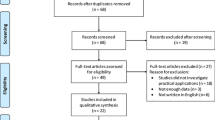Abstract
To coordinate their actions successfully with auditory events, individuals must be able to adapt their behaviour flexibly to environmental changes. Previous work has shown that musical training enhances the flexibility to synchronize behaviour with a wide range of stimulus periods. The current experiment investigated whether musical training enhances temporal adaptation to period perturbations as listeners tapped with a metronome, and whether this enhancement is specific to individuals’ Spontaneous Production Rates (SPRs; individuals’ natural uncued rates). Both musicians and nonmusicians adapted more quickly to period perturbations that slowed down than to those that sped up. Importantly, musicians adapted more quickly to all period perturbations than nonmusicians. Fits of a damped harmonic oscillator model to the tapping measures confirmed musicians’ faster adaptation and greater responsiveness to period perturbations. These results suggest that, even when the task is tailored to individual SPRs, musical training increases the flexibility with which individuals can adapt to changes in their environment during auditory-motor tasks.







Similar content being viewed by others
References
Akaike H (1973) Information theory and an extension of the maximum likelihood principle. In: Petrox BN, Caski F (eds) 2nd Int. Symp. information theory. Akademiai Kiado, Budapest, pp 267–281
Aschersleben G (2002) Temporal control of movements in sensorimotor synchronization. Brain Cogn 48(1):66–79
Elzhov TV, Mullen KM, Spiess A-N, Bolker B (2016) minpack.lm: R interface to the Levenberg-Marquardt nonlinear least squares algorithm found in MINPACK, plus support for bounds. R Package Version 1.2-1. https://cran.r-project.org/web/packages/minpack.lm/minpack.lm.pdf. Accessed 21 Nov 2018
Finney SA (2001) FTAP: a Linux-based program for tapping and music experiments. Behav Res Methods Instrum Comput 33(1):65–72
Holm S (1979) A simple sequentially rejective multiple test procedure. Scand J Stat 6:65–70
Hoyt DF, Taylor R (1981) Gait and the energetics of locomotion in horses. Nature 292(5820):239–240
Krause V, Pollok B, Schnitzler A (2010) Perception in action: the impact of sensory information on sensorimotor synchronization in musicians and non-musicians. Acta Physiol (Oxf) 133(1):28–37
Large EW, Jones MR (1999) The dynamics of attending: how people track time-varying events. Psychol Rev 106(1):119–159
Large EW, Fink P, Kelso JAS (2002) Tracking simple and complex sequences. Psychol Res 66:3–17
Loehr JD, Palmer C (2011) Temporal coordination between performing musicians. Q J Exp Psychol 64(11):2153–2167
Loehr JD, Large EW, Palmer C (2011) Temporal coordination and adaptation to rate change in music performance. J Exp Psychol Hum Percept Perform 37(4):1292
MacKay DG (1982) The problems of flexibility, fluency, and speed-accuracy trade-off in skilled behavior. Psychol Rev 89(5):483–506
Madison G, Merker B (2004) Human sensorimotor tracking of continuous subliminal deviations from isochrony. Neurosci Lett 370:69–73
Palmer C, Zamm A (2017) Interactions in ensemble music performance: empirical and mathematical accounts. In: Lessaffre M, Leman M, Maes PJ (eds) The Routledge companion to embodied music interaction. Routledge, London, pp 370–379
Palmer C, Lidji P, Peretz I (2014) Losing the beat: deficits in temporal coordination. Philos Trans R Soc B 369:20130405
Palmer C, Spidle F, Koopmans E, Schubert P (2019) Ears, heads, and eyes: when singers synchronise. Q J Exp Psychol 72(9):2272–2287
Pecenka N, Keller PE (2011) The role of temporal prediction abilities in interpersonal sensorimotor synchronization. Exp Brain Res 211(3–4):505–515
Peretz I, Champod AS, Hyde K (2003) Varieties of musical disorders: the Montreal Battery of Evaluation of Amusia. Ann NY Acad Sci 999(1):58–75
Peters M (1989) The relationship between variability of intertap intervals and interval duration. Psychol Res 51(1):38–42
Pfordresher PQ, Kulpa JD (2011) The dynamics of disruption from altered auditory feedback: further evidence for a dissociation of sequencing and timing. J Exp Psychol Hum Percept Perform 37(3):949
Repp BH (2002) Phase correction in sensorimotor synchronization: nonlinearities in voluntary and involuntary responses to perturbations. Hum Mov Sci 21(1):1–37
Repp BH (2005) Sensorimotor synchronization: a review of the tapping literature. Psychon Bull Rev 12(6):969–992
Repp BH (2010) Sensorimotor synchronization and perception of timing: effects of music training and task experience. Hum Mov Sci 29(2):200–213
Repp BH, Su Y-H (2013) Sensorimotor synchronization: a review of recent research (2006-2012). Psychon Bull Rev 20(3):403–452
Scheurich R, Zamm A, Palmer C (2018) Tapping into rate flexibility: musical training facilitates synchronization around spontaneous production rates. Front Psychol 9:458
Strogatz SH, Stewart I (1993) Coupled oscillators and biological synchronization. Sci Am 269:102–109
R Core Team (2012) R: a language and environment for statistical computing. R Foundation for Statistical Computing, Vienna, Austria. https://www.R-project.org/. Accessed 21 Nov 2018
Thaut MH, Miller RA, Schauer LM (1998) Multiple synchronization strategies in rhythmic sensorimotor tasks: phase vs period correction. Biol Cybern 79:241–250
Zamm A, Pfordresher PQ, Palmer C (2015) Temporal coordination in joint music performance: effects of endogenous rhythms and auditory feedback. Exp Brain Res 233(2):607–615
Zamm A, Wellman C, Palmer C (2016) Endogenous rhythms influence interpersonal synchrony. J Exp Psychol Hum Percept Perform 42(5):611
Zamm A, Wang Y, Palmer C (2018) Musicians’ natural frequencies of performance display optimal temporal stability. J Biol Rhythm 33(4):432–440
Acknowledgements
This research was supported by a Natural Sciences and Engineering Research Council of Canada (NSERC) Collaborative Research and Training Experience (CREATE) fellowship to Rebecca Scheurich, a Fulbright award to Peter Pfordresher, and NSERC Grant 298173 and a Canada Research Chair to Caroline Palmer. We are grateful to Maya Aharon, Jamie Dunkle, Frances Spidle, and Anna Zamm for their assistance.
Author information
Authors and Affiliations
Corresponding author
Ethics declarations
Conflict of interest
The authors declare that they have no conflict of interest.
Additional information
Communicated by Melvyn A. Goodale.
Publisher's Note
Springer Nature remains neutral with regard to jurisdictional claims in published maps and institutional affiliations.
Electronic supplementary material
Below is the link to the electronic supplementary material.
Rights and permissions
About this article
Cite this article
Scheurich, R., Pfordresher, P.Q. & Palmer, C. Musical training enhances temporal adaptation of auditory-motor synchronization. Exp Brain Res 238, 81–92 (2020). https://doi.org/10.1007/s00221-019-05692-y
Received:
Accepted:
Published:
Issue Date:
DOI: https://doi.org/10.1007/s00221-019-05692-y




